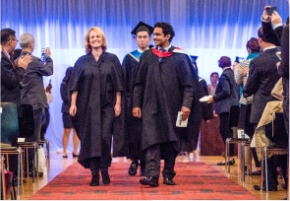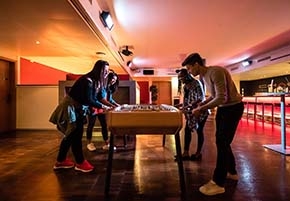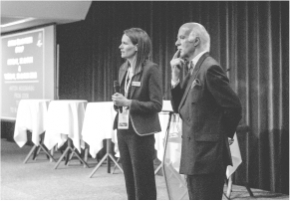- About
- Programs
- Innovation & Research
- Campus Life
- Career Services
- Admissions
- News & Events
- Alumni
Integrating Play-Based Learning in Higher Education
Albert Einstein once declared that “play is the highest form of research”, and modern neuroscience has proved that the great theoretical physicist was right: games can and do play a key role in cognitive development.
Play-based learning is often associated with early childhood education, where it serves as a foundational approach for engaging young children with new concepts. However, this learning method also proves to be effective in higher education.
Play-based learning allows students to actively explore subjects, experiment with real-life situations, and immerse themselves in creative problem-solving—all within a playful context.
In a traditional academic setting, higher education can sometimes lean heavily towards lectures, rote memorization, and rigid assessment methods. This approach, more often than not, contributes to students' stress, disengagement, and a lack of innovation. In contrast, incorporating play-based learning brings a breath of fresh air into higher education, helping students become more connected to their coursework and ultimately achieving a deeper level of understanding.
Benefits of Play-Based Learning in Higher Education
The effectiveness of play-based learning is evident in its numerous benefits. In higher education, where engagement and mental well-being are crucial for success, this approach helps cultivate a more stimulating and supportive learning environment.
Enhances student engagement
Student engagement is a key challenge in higher education, especially when lectures or learning materials become monotonous. Play-based learning introduces an element of excitement and curiosity into the classroom, drawing students in with activities like role-playing, challenges, and collaborative games.
When students are engaged, they are more likely to retain information, contribute to discussions, and genuinely care about their learning.
Encourages creativity and innovation
Play-based learning is about exploration, experimentation, and taking risks—critical factors for fostering creativity. When students engage in activities that challenge them to think outside the box, they learn to apply new ideas in different situations.
For example, design thinking workshops can inspire students to develop creative solutions to real-world problems, helping them tackle challenges in fresh, innovative ways. This environment nurtures a growth mindset, where mistakes aren't setbacks but opportunities to learn and improve.
Facilitates deeper learning
Students participating in play-based activities are more than passively absorbing information. Instead, they actively engage with concepts, apply them to practical scenarios, and learn by doing. This hands-on approach allows students to develop a deeper understanding of the material.
By connecting what they learn and how it applies in the real world, students are more likely to develop a solid and lasting comprehension of the subject.
Develops soft skills
In addition to fostering deeper subject knowledge, play-based learning is highly effective in helping students develop soft skills. Activities that emphasize collaboration, problem-solving, and adaptability enhance skills like teamwork, communication, and leadership.
For example, role-playing scenarios allow students to put themselves in someone else's shoes, practicing empathy and negotiation. These exercises build critical interpersonal skills often underdeveloped in traditional academic settings.
Reduces stress and improves well-being
Play-based learning also contributes to students' emotional well-being. The traditional, high-stakes environment of higher education often leads to increased stress levels and burnout. By incorporating play into the learning experience, educators can create a more relaxed atmosphere that encourages students to enjoy the process of learning.
Play-based activities tend to be more collaborative and fun, reducing anxiety, promoting a sense of community, and ultimately improving overall mental health.
Your Hopitality Journey Starts Here
Master the art of hospitality management
Examples of Play-Based Learning in Higher Education
Play-based learning can be adapted to higher education through various methods. Here are some of the best ways to do so:
Gamification of courses
One helpful example of play-based learning in hospitality education is the gamification of courses. Gamification involves incorporating game elements—such as point systems, rewards, challenges, and leaderboards—into the curriculum.
For instance, a course on hotel management might use a virtual hotel simulation where students earn points for efficiently managing different aspects of hotel operations, such as guest satisfaction, revenue, and employee performance.
Students could progress through different levels, from managing a small boutique hotel to a large luxury resort, gaining valuable experience in problem-solving and resource management.
Simulation-based learning
Simulation-based learning is another powerful tool for hospitality students. It allows them to replicate real-world scenarios in a controlled environment.
For example, students might participate in a restaurant management simulation, in which they handle everything from inventory control to customer service. Another example is a crisis management simulation, in which students address issues like food safety incidents or natural disasters affecting a resort.
These experiences enable students to practice decision-making and critical thinking in situations they are likely to face in the hospitality industry, all while receiving immediate instructor feedback.
Design thinking workshops
Design thinking workshops offer hospitality students a hands-on approach to solving real-world challenges. In these workshops, students work through different phases—empathizing, defining, ideating, prototyping, and testing—to develop innovative solutions.
Students could be tasked with redesigning the layout of a hotel lobby to improve the guest experience. By brainstorming, prototyping, and testing different concepts, students learn to think creatively and understand guest needs from multiple perspectives.
Role-playing and case study scenarios
Role-playing and case-study scenarios are other effective ways for hospitality students to understand various industry perspectives. Students might role-play as different hotel team members, such as a front desk manager, a housekeeping supervisor, and a demanding guest, to learn about hotel operations and customer service dynamics.
In another scenario, students could act as event planners tasked with coordinating a large conference, handling everything from budgeting to vendor negotiations. These role-playing activities help students apply theoretical knowledge in practical situations, fostering empathy, teamwork, and effective communication—all critical skills in the hospitality field.
How Educators Can Incorporate Play-Based Learning
Educators can adopt several effective strategies to integrate play-based learning into their teaching, making the learning experience more engaging and practical for students.
Designing playful learning environments
The physical space of a classroom can significantly influence students' willingness to participate in play-based learning. In hospitality education, educators can create environments that mimic real-life settings, such as mock hotel lobbies, restaurant dining areas, or front desk setups.
Flexible seating arrangements, open areas for role-playing, and interactive whiteboards for brainstorming help create an inviting atmosphere that fosters creativity.
The goal is to create an open, inviting atmosphere where traditional desk arrangements do not restrict students. When students are comfortable and encouraged to move around, they are more likely to engage in collaborative and playful activities.
Integrating technology
Technology is key in enhancing play-based learning and offering immersive and interactive experiences. For hospitality students, virtual reality (VR) can be used to conduct virtual tours of luxury resorts, enabling them to understand guest experience and hotel operations in a lifelike manner.
Augmented reality (AR) could provide a deeper look into kitchen operations, showcasing how dishes are prepared step-by-step or giving students a behind-the-scenes look at a working hotel.
This approach could help educators make abstract concepts more tangible, giving students a deeper understanding of the hospitality industry's complexities.
Collaborative learning projects
Collaborative projects are another way to incorporate play into learning, promoting teamwork and problem-solving. Educators can assign group projects where students work together to design a new restaurant concept, including creating menus, developing a marketing plan, and determining staffing needs.
Another example is a challenge where students must organize a themed event at a mock hotel, taking on roles such as event coordinator, marketing manager, and guest relations specialist. These collaborative projects help students understand the interconnected nature of the hospitality industry while fostering creativity, innovation, and harmony.
The Future of Play-Based Learning in Higher Education
With a growing emphasis on student well-being, mental health, and soft skills development, universities and colleges are starting to recognize the value of incorporating playful elements into their curricula. The integration of technology and a shift towards more experiential and student-centered learning will likely lead to the broader adoption of play-based methods.
Moreover, as employers continue to seek adaptable, creative graduates with strong interpersonal skills, the demand for play-based learning approaches that foster these attributes will only increase.
This transformation could redefine the higher education experience, moving away from a model based solely on lectures and exams to one that encourages exploration, experimentation, and personal growth.
Conclusion
Play-based learning in higher education represents a powerful shift towards a more engaging, creative, and effective form of learning. By enhancing student engagement, fostering creativity, facilitating deeper learning, developing soft skills, and reducing stress, this approach addresses many challenges traditional higher education systems face. Incorporating play into the learning process makes education more enjoyable and prepares students for the complexities of the real world by equipping them with essential skills and a growth mindset.
Frequently Asked Questions (FAQs)
What are the challenges of play-based learning?
One of the primary challenges of play-based learning is the perception that it lacks rigor, which can make it challenging to implement in higher education environments that emphasize traditional assessments and standards. Additionally, designing effective play-based activities requires time and creativity on the part of educators, which can be a barrier when resources are limited. There may also be resistance from students accustomed to conventional learning methods who find it difficult to adapt to a less structured approach.
What are some misconceptions about play-based learning?
A common misconception about play-based learning is that it's only suitable for young children. However, as highlighted throughout this article, play-based learning can be highly effective in higher education, helping students grasp complex concepts and develop essential life skills. Another misconception is that play-based learning is simply "fun and games" without educational value. In reality, well-designed play-based activities are deeply educational and provide a meaningful context for students to apply their knowledge in creative and practical ways.
Your Hopitality Journey Starts Here
Master the art of hospitality management
#Academics

















